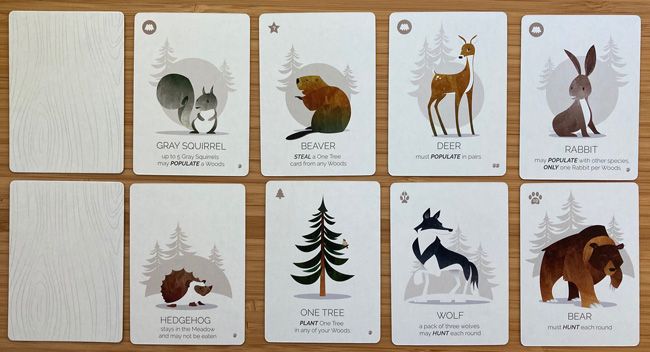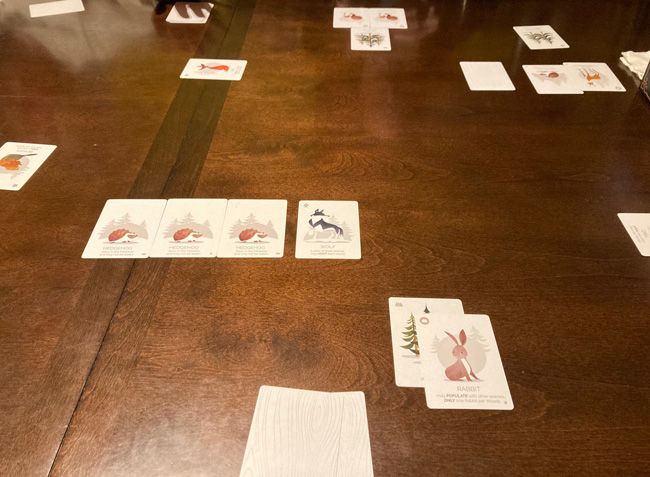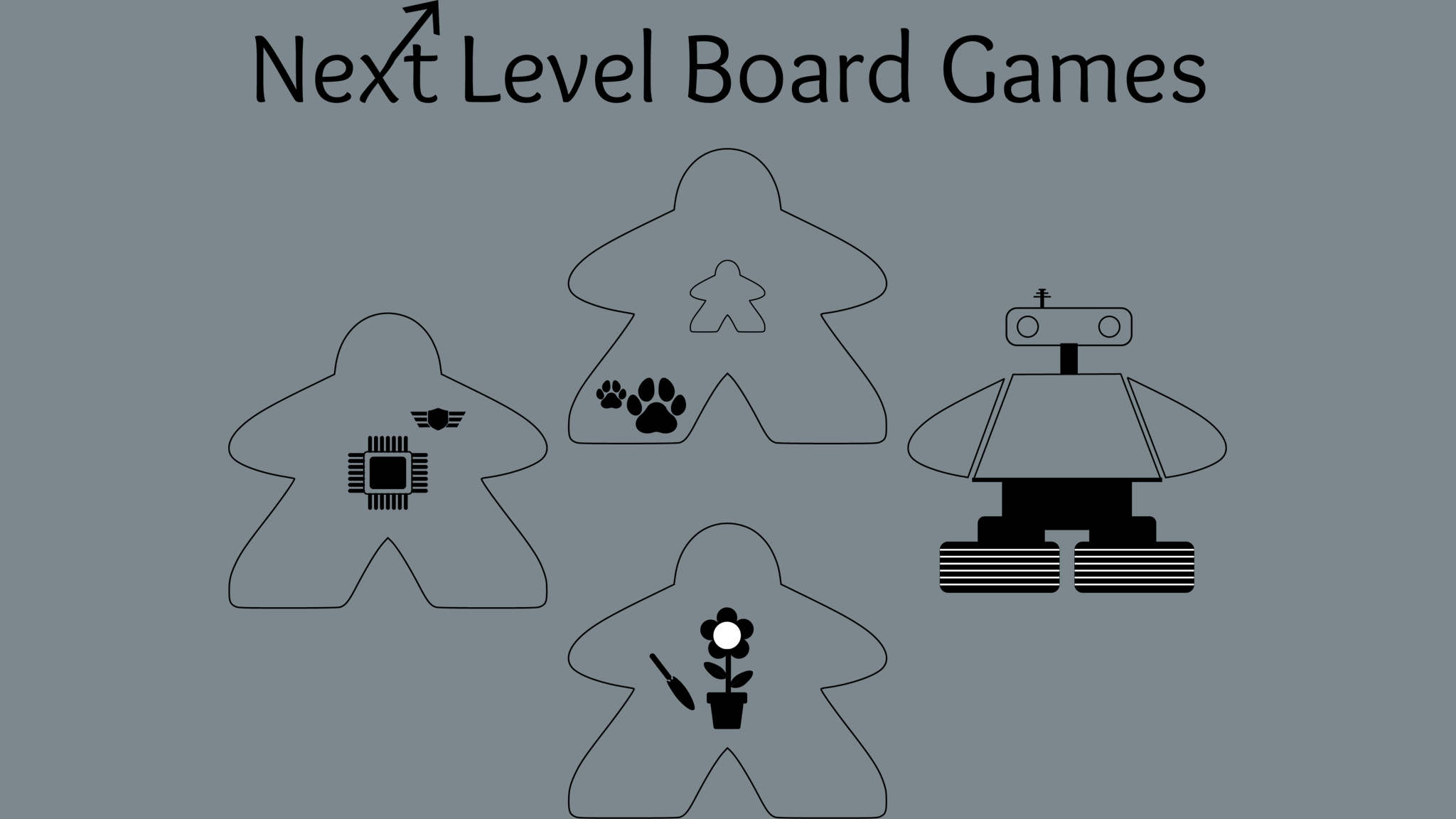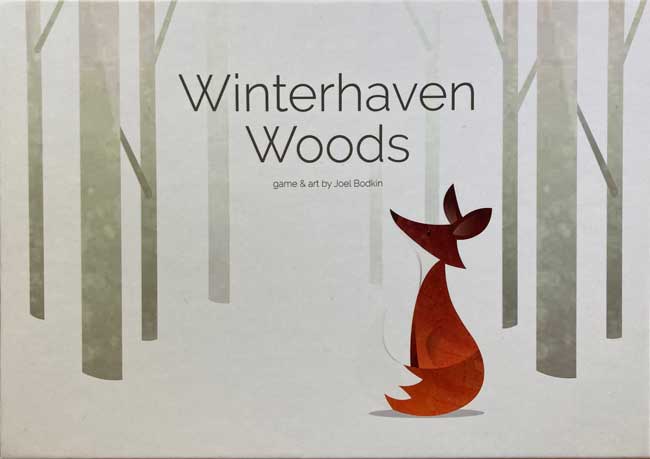Winterhaven Woods is a game published by Featherstone Games. The premise of the game is for players to create the most beneficial woodlands so they can populate them with animals preparing to endure the long winter months ahead. The game end is triggered after three rounds, at which point all players count up their creatures and bonuses and the player with the most points is declared the winner.
To see what is in the box, watch this unboxing video:
This post is broken into the following 3 sections, feel free to jump directly to one:
- General summary - consisting of information about overall enjoyment, theme, replayability, and upgrades
- Complexity - consisting of information about the rulebook, setup, player turns, and overall learning curve
- Player turns - consisting of game type, game flow, rule you are likely to miss, and favorite aspect
General Summary
Number of players we had: 4
Our play time (not including setup): 30 minutes
Table size needed: Small, 4'
Overall enjoyment

Overall our group really enjoys playing this game, even knowing another players' attack can change your entire game at any time! Winterhaven Woods is a card game played over three rounds. Players draw a hand of cards each round via a card drafting system and the number of cards is based on the number of players. Players keep just one card, then pass their cards to the player next to them and repeat until all cards have been chosen for the round.
Drafting your hand each round means you are constantly reassessing what might be your smartest move, all the while aware that you have no way of knowing what other cards you may come across. We love the unpredictability this brings in addition to what other players choose to do, which can benefit you as much as it can tank your plans. The game plays fast, sets up and is learned quickly, and we are always left wanting to play again. Lastly, we absolutely love the artwork and the amount of care taken in all of the details of each card, the rule book and the rules themselves.
Theme

If you like animals or nature, you will love the artwork in this game. As a fan of both animals and the outdoors, I instantly fell in love with the aesthetics of this game. The artwork is calming and incredibly sweet, though the game is dynamic and has some surprising elements of attack that you cannot predict. The backs of the cards are even decorated to look like the wood grain on a tree. Lastly, even though it is a smaller card game, it came with a scoresheet booklet which is a nice addition!

Replayability

There are several things that increase the replayability of this game, including:
- Each game is only three rounds made up of five steps, some of which occur simultaneously, meaning players are engaged throughout the game.
- The types of hands players are dealt vary greatly from round to round and game to game.
- Games with card drafting vary greatly based on the types of players and even how the same players explore different strategies over time.
- There are several ways to earn points towards the end-of-game scoring and include moves that play it safe, risking it all, and a hybrid of something in between.
Upgrades
I am not aware of any upgrades for this game, however, there is an expansion called Winterhaven Wonders that adds some additional elements to the original game.
Complexity
Rule book
The rule book is fairly small and organized, and fits perfectly in the small game box. There are images of the cards along with the explanations, but more importantly, rules that are specific to how each animal behaves are also printed on their cards! This means players do not have to remember the rules read to them and it makes the game easier to learn and quicker to begin playing. It might seem like a small detail, but it shows the level of planning put into the game.
Setup
Setting up a game takes about five minutes. After giving each player a starting Heart of the Woods card to place in their play area, the cards are shuffled and players are dealt a hand size based on the number of players. Players then choose one card from their hand, place it face down in their meadow, and pass the remainder. This repeats until all cards have been chosen. The remaining cards are placed in the center of all players and round one is ready to begin.
Turns
Each round consists of five steps. These include:
- Choosing your hand - each player is dealt a number of cards based on the number of players. Then players choose one card to keep and pass the rest. Once all cards have been chosen, play moves on to the next step.
- Planting trees - players plant any trees they collected by adding them to an existing woods or creating a new one, up to a maximum of three woods.
- Populating their woods with critters they collected, based on the rules of placement which varies by animal.
- Stealing cards - some animal cards, like owls, allow you to potentially steal animals or trees from other players, but can also come at a cost at the end of the game. You will want to use these sparingly!
- Hunting - certain animal cards need to hunt to be of value. Bears, and packs of wolves, can hunt each round which will gain you additional end-of-game points.
The choosing a hand, planting and populating woods steps are done simultaneously. Stealing cards and hunting is done one player at a time based on the number on the cards that allow the actions, going from lowest to highest.
Overall learning curve
The overall learning curve for this game is very low, however, that does not mean it is easy to win. There are many twists and turns introduced by the steal and hunt action, as well as the card drafting phase as you can only fully plan your turn when you have collected your last card for the round.
Player Turns
Play type
Winterhaven Woods is a symmetrical card game with drafting and set collection, in addition to other players having the ability to affect your game directly by stealing cards and possibly ruining an established and populated woods.
Some cards cannot be stolen, like the hedgehogs, which are of course worth fewer points at the end of the game, but remain secure. Other cards need to be played in pairs, like the deer, or require a pack of three to be able to hunt, like the wolves. The unpredictability of the cards you will have to choose from during each drafting phase means each decision must be fully considered to ensure the greatest benefits.

Game flow
The flow of this game is fast and fun. Several parts are done simultaneously by all players, such as card drafting, planting woods and populating them. Stealing and hunting can affect anyone as you never know what cards may be taken from your meadow. This means all players are paying attention as they may be hoping to steal or hunt those very same animals!
Rule you are likely to forget/miss
The one rule you are likely to forget/miss is that you can only have three woods. A woods is defined as having at least three trees in it. Only being able to have three woods is important to note because most of the animals in the forest will not populate if other animals are already there, with the exception of the rabbit, which is limited to one in any woods.
Favorite aspect
Our favorite aspect of this game is how complex it can be for a small and quick game. The artwork is lovely and it is easy to set up, teach other players, and learn, yet there is plenty of challenge to it and each game plays very differently. There are lots of different strategies players can choose to follow to earn more points, and each other players' choices also affect your game. This means players must constantly adapt, even during the drafting phase, if they want to successfully populate their woods and hope for a high point total at the end.
Winterhaven Woods is a great game to teach new players, travels well as it has such a small footprint and is a fantastically designed card game that will be on our shelves for a very long time to come!


